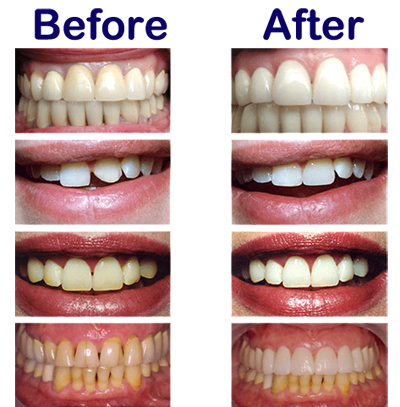TREATMENTS
PORCELAIN VENEERS / COSMETIC DENTISTRY / SMILE DESIGNFrom subtle changes to major repairs, we can perform a variety of procedures to improve your smile. There are many techniques and options to treat teeth that are discolored, chipped, misshapen or missing. The dentist can reshape your teeth, close spaces, restore worn or short teeth or alter the length of your teeth. Common procedures include bleaching, bonding, caps, crowns, veneers, and reshaping and contouring.
These improvements are not always cosmetic. Besides improving your self Esteem and enhancing your Career Prospects it also helps to find a cuter spouse!
BleachingBleaching is a common and popular chemical process used to whiten teeth. Some people get their teeth bleached to make stains disappear, while other just want a whiter shade.
Discoloration occurs in the enamel and can be caused by medication, coffee, tea and cigarettes.
Discoloration also can be caused by your genetic make-up or simply getting older. Bleaching can be performed by the dentist in the office or, under supervision, at home. Many patients enjoy bleaching at Dental Office because it is more convenient. Treatment begins when the dentist creates a custom mouthpiece to ensure the correct amount of whitening solution-10 percent to 20 percent carbamide peroxide-is used and that your teeth are properly exposed. Typically, whitening at home takes two or three weeks, depending on the desired shade you wish to achieve. Whitening in the office may call for 45 to 60- minute visit to the dentist’s office.

Bonding is tooth-colored material used to fill in gaps or change the color of teeth. Requiring a single office visit, bonding lasts several years. Bonding is more susceptible to staining or chipping than other forms of restoration. When teeth are chipped or slightly decayed, bonded composite resins may be the material of choice. Bonding also is used as a tooth-colored filling for small cavities and broken or chipped surfaces. Additionally, it can be used to close spaces between teeth or cover the entire outside surface of a tooth to change its color and shape.
CrownsCrowns are also known as caps, are used in cases where other procedures will not be effective. Crowns have the longest life expectancy of all cosmetic restorations.
LaminatesLaminates are placed over the front teeth to change color or shape of your teeth. Laminates are used on teeth with uneven surfaces or are chipped, discolored, oddly shaped, unevenly spaced or crooked. Laminates are thin pieces of porcelain or plastic cemented over the front of your teeth. Little or no anesthesia is needed. Laminates are used to treat some of the same problems as bonding. The procedure requires the dentist to take an impression of your tooth. Before the custommade veneer is glued directly onto the tooth, the dentist will lightly buff the tooth to compensate for the added thickness of the veneer. Once the cement is between the veneer and your tooth, a light beam is used to harden it. Porcelain veneers are fabricated in a laboratory & therefore have a longer life expectancy and color stability than bonding.
ORAL SURGERIES (INCLUDING TREATMENT OF FRACTURED JAWS)
An oral surgeon is a dentist who specializes in different aspects of surgery both in and around the mouth. They diagnose and treat defects, injuries, and diseases involving the head, mouth, teeth, gums, jaws, and neck.
At Malhotra Dental Care Centre we follow procedures to remove teeth painlessly and emphasise on saving as much of the supporting bone and gum tissues as possible. This is important because strong structures provide essential support for your implants, bridges, or dentures leading to the best possible functional and cosmetic results. An oral surgeon can carry out a wide range of procedures.
Dental CrownsCrowns, also known as caps, restore damaged teeth and mimics the shape, size and color of the surrounding teeth. Crowns are indicated for cracked teeth and teeth with deep cavities; to protect teeth that have been filled by root-canal treatment; to provide extra support for bridges; and to cover poorly shaped or discolored teeth. Crowns may be made of metal, porcelain, or newer restorative materials like metal free ceramics. They are custom-made and fitted for each patient in conformation with the size and length of the natural teeth. Crowns typically last five to eight years, but can last much longer with proper oral hygiene. Crowns can be made of a variety of materials. They can be made of plastic, ceramic or metal alloys. A combination of metal and ceramic is also possible to maximize strength and simulate the appearance of natural teeth. The teeth to be crowned are prepared which involves reduction of the tooth size (usually under local anaesthesia) followed by an impression or mould of the prepared tooth. This trimming of the tooth is required to create space for the crown to be fitted. The mould taken is then sent to a laboratory where skilled technicians will fabricate the crown. In the meanwhile, a temporary crown is made and fitted onto the trimmed tooth.
Dental BridgesA bridge stabilizes the bite of a patient who is missing one or more teeth. Bridges prevent the surrounding teeth from moving or shifting in the mouth. A missing tooth that is not replaced may cause surrounding teeth to become unstable and require removal, compromising oral health or change the shape of the face and diminish the beauty of a smile. Unlike partial dentures, bridges are permanent; patients need not remove them. The missing tooth is replaced with an artificial tooth connected between two crowns (caps), which are permanently cemented or bonded on the adjacent teeth. Bridges can be used to replace a small number of missing teeth if the neighboring teeth are sufficiently strong. The number of missing teeth, condition of the neighboring teeth, condition of the supporting gums and bone are all important factors which need to be assessed prior to making a bridge.
